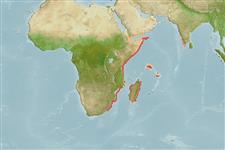Environment: milieu / climate zone / depth range / distribution range
Écologie
marin bathydémersal; profondeur 180 - 380 m (Ref. 126083). Deep-water
Western Indian Ocean: Kenya, Mozambique and South Africa.
Taille / Poids / Âge
Maturity: Lm ? range ? - ? cm
Max length : 19.0 cm TL mâle / non sexé; (Ref. 4417)
Rayons mous dorsaux (Total): 105-115; Rayons mous anaux: 83 - 96; Vertèbres: 51 - 53. This species is distinguished by the following characters: head length 5.0-6.9, body
depth 2.6-3.1 in SL; upper profile no notch anterodorsal to upper margin of upper eye; snout
rounded; upper jaw shorter than lower eye diameter; teeth on lower jaw of the blind side in 1-2 rows; pectoral-fin length of ocular side 3.1-4.7 in SL, nearly twice as long as HL; dorsal fin beginning behind posterior nostril of blind side, the first two rays detached from other rays of the fin, and dorsal-fin pterigiophores shorter than neural spines of first four caudal vertebrae; D 105-115, A 83-96, pectoral-fin rays on ocular side 12, blind–side 11, lateral line scales about 94, gill rakers 5 + 11, vertebrae 11 + 40-42 (Ref. 126083).
Life cycle and mating behavior
Maturité | Reproduction | Frai | Œufs | Fécondité | Larves
Voronina, E.P., J. Maclaine, S. Raredon and P. Pruvost, 2020. Revised diagnoses, nomenclature, distribution and key for identification of the species of the Indo-Pacific genus Laeops (Bothidae). J. Ichthyol. 60(6),801-827. (Ref. 126083)
Statut dans la liste rouge de l'IUCN (Ref. 130435)
Menace pour l'homme
Harmless
Utilisations par l'homme
Plus d'informations
Noms communsSynonymesMétabolismePrédateursÉcotoxicologieReproductionMaturitéFraiRassemblement de ponteFéconditéŒufsDéveloppement de l'œuf
RéférencesAquacultureProfil d'aquacultureSouchesGénétiqueElectrophoresesHéritabilitéPathologiesTraitementNutrientsMass conversion
Outils
Articles particuliers
Télécharger en XML
Sources Internet
Estimates based on models
Preferred temperature (Ref.
123201): 13.5 - 18.4, mean 15.2 °C (based on 17 cells).
Phylogenetic diversity index (Ref.
82804): PD
50 = 0.5001 [Uniqueness, from 0.5 = low to 2.0 = high].
Bayesian length-weight: a=0.00912 (0.00408 - 0.02036), b=3.05 (2.87 - 3.23), in cm total length, based on LWR estimates for this (Sub)family-body shape (Ref.
93245).
Niveau trophique (Ref.
69278): 3.6 ±0.4 se; based on size and trophs of closest relatives
Résilience (Ref.
120179): Milieu, temps minimum de doublement de population : 1,4 à 4,4 années (Assuming tmax>3).
Fishing Vulnerability (Ref.
59153): Low vulnerability (10 of 100).
